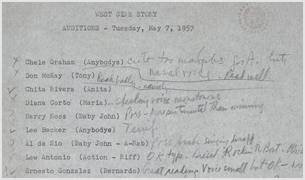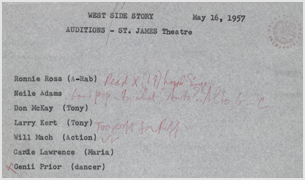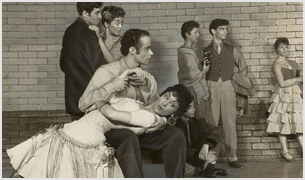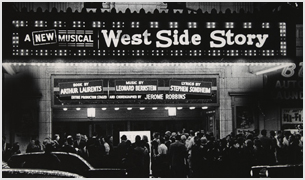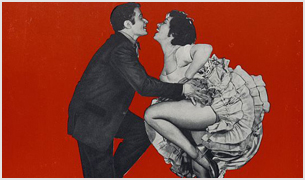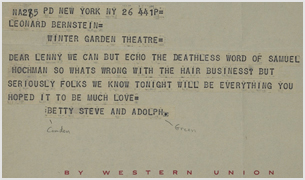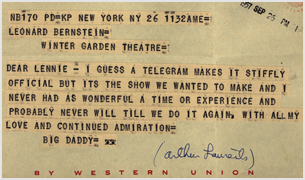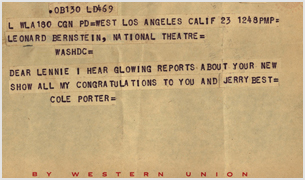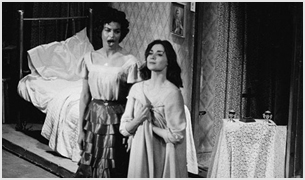
Birth of a Musical
The Broadway musical is a commercial art form that often aspires to, and occasionally attains, high art. It is also a collaborative medium, in which the librettist, composer, lyricist, director, and choreographer determine together the details of plot and action, the style and tone of the production, and how music, movement, and language will be used to best convey the story they wish to tell. The collaboration also involves dozens of people who play key roles, including the designers of the set, lighting, and costumes, the orchestrators and musicians, and ultimately the performers who must embody not only the characters they play, but also must be able to sing and dance—in the case of West Side Story—this most demanding music and choreography. The items on display in this section come from the Library’s Leonard Bernstein Collection and provide a rare window into this complex process.
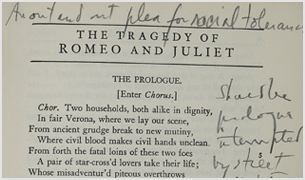
William Shakespeare. Romeo and Juliet.
Boston: Ginn and Co.,
1940. Ed. by George Kittredge.
Leonard Bernstein Collection, Music Division (1)
By permission of The Leonard Bernstein Office, Inc.
Bernstein's Annotated copy of romeo and juliet
Throughout this volume Bernstein made several notes for adapting Shakespeare’s play into a contemporary musical. In its early stage of development Jerome Robbins, Arthur Laurents, and Leonard Bernstein considered replacing the feuding artistrocratic families with a Catholic and Jewish family. On the inside cover is a scene breakdown suggesting that the show open either at the Mulberry Street Festival or during Easter and Passover. Elsewhere, Bernstein’s notes suggest that a song entitled “Song on Racism” instead be entitled “It’s the Jews.” At the top of the title page, Bernstein writes “An out and out plea for racial tolerance,” and in the margin “Should be prologue interrupted by street fight.”
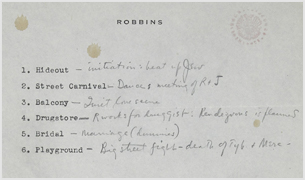
Jerome Robbins and Leonard Bernstein.
Scene breakdown
ca. 1949. Typescript with holograph annotations.
Leonard Bernstein Collection, Music Division (2)
Used by permission of The Robbins Rights Trust
Early Scene breakdown
This early scene breakdown—presumably typed by Jerome Robbins with Bernstein’s annotations in pencil shows the collaborative process between these two artists. Bernstein’s notes reveal that although the character names still come from Shakespeare—Romeo, Juliet, Tybalt, and Mercutio—the feud is now based on Jewish and Catholic prejudices.
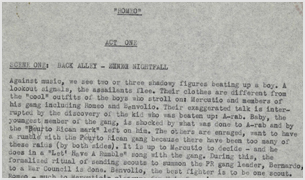
Arthur Laurents. Romeo Synopsis
October 1955. Typescript
Leonard Bernstein Collection, Music Division (51)
By permission of The Leonard Bernstein Office, Inc.
Romeo Synopsis
Shown here is the first page of a six-page synopsis by Arthur Laurents. Although several of the details would eventually change (including most of the character names), many moments are richly described in this early version and were closely realized in the final show, including the description of Romeo and Juliet’s (Tony and Maria’s) meeting in act 1, scene 2.
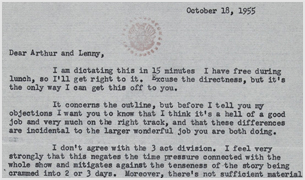
Jerome Robbins to Leonard Bernstein and Arthur Laurents, with annotations by Leonard Bernstein,
October 18, 1955. Typescript letter.
Leonard Bernstein Collection, Music Division, Library of Congress (4)
Used by permission of The Robbins Rights Trust
Letter from Jerome Robbins
Jerome Robbins wrote this thoughtful and detailed reaction to Arthur Laurents’s Romeo synopsis. Notable among Robbins’s responses are: his argument for a two-act division (p. 1, par.3); his suggested changes to Anita’s character (p. 1, par. 5); his expressed concerns about the “wedding scene” (p. 2, par. 3); his overall philosophy regarding what the work needs to convey (p. 3, par. 2); and his thoughts on casting and the use of dance in the show (p. 3, par. 3). The annotations in the margins, mostly in agreement, are in Leonard Bernstein’s hand.
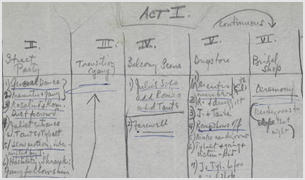
Leonard Bernstein. Scene Outline with notes regarding songs
ca. 1949. Holograph manuscript.
Leonard Bernstein Collection, Music Division, Library of Congress (5)
By permission of The Leonard Bernstein Office, Inc.
Scene Outline with Notes on Songs and Music
In this outline, Bernstein makes notes about song placement, participants, and the tone of musical numbers. Here he describes scene I as “Dogged, intense”; scene II includes a “Duet to crowd” by Romeo and Rosalind (his erstwhile girlfriend); scene V opens with a number for Mercutio “with girls”; and before the fight and double murder in scene VII, Bernstein suggests a “happy song” for Romeo.
Audition Notes
Twenty pages of lists and notes on cast auditions for West Side Story in the Bernstein Collection record not only the broad range of actors who tried out for the play, but also provide insight into what Bernstein was seeking in a cast. Surprises among those auditioning are Suzanne Plechette (“hoarse”), Warren Beatty (“Good voice—can’t open his jaw—charming as hell—cleancut”), Jerry Orbach (“Good read. Good loud bar[itone]”), and Artie Johnson (“Good singer”). Among those actually cast, Larry Kert, who landed the role of Tony, initially auditioned for the roles of Bernardo and Rigg. As Bernstein comments: “Great singer + performer. But looks? Read Riff Better.” The original Maria, Carol Lawrence, is here described as “Lovely soprano. Not quite Maria. Much realer with accent.”

Leonard Bernstein outside the National Theatre in Washington, DC
Robert H. Phillips, photographer.
Leonard Bernstein Collection, Music Division, Library of Congress (27)
Courtesy of the estate of the photographer
Leonard Bernstein outside the National Theatre in Washington, DC
West Side Story began its out of town performances at the National Theatre in Washington, D.C. on August 19, 1957. After a two-week run at Philadelphia’s Erlanger Theatre, the show opened on Broadway at the Winter Garden Theatre on September 26, 1957. In this photograph taken for Life Magazine, a euphoric Leonard Bernstein leaps under the marquee for West Side Story after the show’s opening at the National Theatre in Washington, D.C.
Opening Night Telegrams
Leonard Bernstein saved approximately 140 opening night telegrams that he received when West Side Story opened on Broadway. Included in those saved are the seven on display here: (a) from Betty Bogart, wife of Humphrey Bogart and best known as Lauren Bacall; (b) from Harold “Hal” S. Prince and Robert “Bobbie”E. Griffith, the show’s producers who, presumably intentionally mangled the song title “Maria” as “Martha”; (c) from the lyricists/librettist team of Betty Comden and Adolph Green, previous Bernstein collaborators, referencing Bernstein’s father, Samuel, who had wanted his son to join and take over the family business—the Samuel Bernstein Hair Company; (d) from librettist Arthur Laurents; (e) from Carol Lawrence, the original Maria; (f) from Roger Stevens, an early producer and constant supporter; (h) and from songwriter Cole Porter. Bernstein received a surprising number of telegrams from the leading Broadway songwriters of the day, including Harold Arlen, Dorothy Fields, Burton Lane, Alan Jay Lerner, Richard Rodgers, Arthur Schwartz, and Jule Styne.
[Library of Congress does not have permission to post wss0056 online]
Production Photographs
In spring of 1958, Look magazine had planned a feature spread on Carol Lawrence, the original Maria. Photographer Paul Fusco took hundreds of photographs of Ms. Lawrence, including dozens of production shots from West Side Story. Although Look never ran the article, the photographs, several of which are seen here for the first time, offer rare views of the original Broadway production. [The Library had the first prints made from the original negatives for this exhibition.]
Paul Fusco, photographer. Look Magazine Photograph Collection, Prints and Photographs Division, Library of Congress (34-44)
© Paul Fusco/Magnum Photos
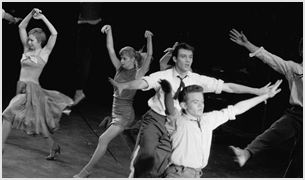
“The Dance at the Gym, ” an extended dance number full of energetic popular music styles from rock to mambo, includes a sequence where time seems to magically stop as Tony and Maria (played by Larry Kert and Carol Lawrence) first meet and lock eyes. (34)

In the bridal shop where Maria works, she and Tony exchange vows as they “marry” each other while singing the tender “One Hand, One Heart.” (40)
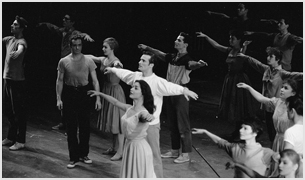
From the “Somewhere Ballet,” a dreamlike scene in which Tony, Maria, and the rest of the cast imagine a world without prejudice or violence. (36)

From the “Somewhere Ballet,” a dreamlike scene in which Tony, Maria, and the rest of the cast imagine a world without prejudice or violence. (43)

A furious Anita confronts Maria about Tony’s killing of Bernardo, Maria’s brother and Anita’s boyfriend, damning Tony in the song “A Boy Like That.” Maria counters with the passionate “I Have a Love.” (41)





